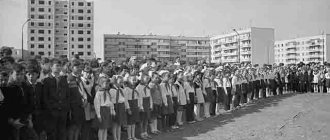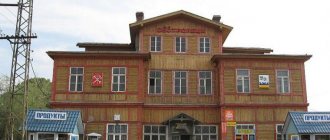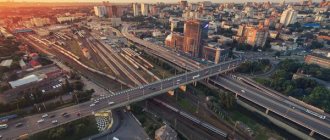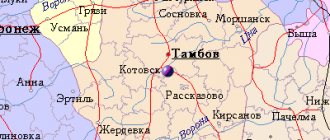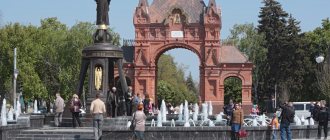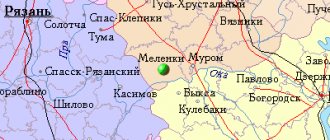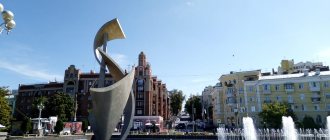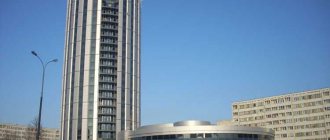Here are 121 cities and towns in our country whose names begin letter D. By clicking on the name of the city, you will be taken to a page with a description of the main attractions of the city and its interactive map.
- simple font indicates cities in which there is only one object (attraction, hotel, cafe, service point, etc.)
- thick font
indicates cities that have several objects - Popular cities are highlighted in green
Each city's page lists hotels, cafes (restaurants), souvenirs and services for travelers. For each attraction, hotel, service, photographs and reviews of real visitors are collected, the objects are sorted by rating, calculated based on reviews.
Just below, 51 foreign cities starting with the letter D are listed separately.
Social toponyms starting with the letter D
Countries starting with the letter D
- Denmark (Europe).
- Djibouti is a country in Africa.
- Dominica (Commonwealth of Dominica) is a state in Central America
- Dominican Republic is a country in Central America
Internal areas starting with the letter D
- Dagestan is a republic in the North Caucasus (Russia).
Capitals and major cities starting with the letter D
- Dakar is the capital of Senegal (Africa).
- Dhaka is the capital of Bangladesh (Hindustan).
- Damascus is the capital of Syria (Middle East).
- Delhi is the capital of the Republic of India (Hindustan).
- Jakarta is the capital of Indonesia (Indonesian archipelago).
- Djibouti is the capital of Djibouti (Africa).
- Georgetown is the capital of Guyana (South America).
- Dili is the capital of East Timor, Indonesian archipelago).
- Dnepropetrovsk (Ekaterinoslav) - the center of the Dnepropetrovsk region of Ukraine
- Donetsk is the center of the Donetsk region of Ukraine
- Dodoma is the capital of Tanzania (Africa).
- Doha is the capital of Qatar (Arabia).
- Dresden is a city in Germany, the administrative center of Saxony, on the Elbe River.
- Dublin is the capital of Ireland (Europe).
- Dushanbe is the capital of Tajikistan.
Names of regional centers (and interesting villages) starting with the letter D
- Dinskaya is a regional center in the Krasnodar Territory.
How to play?
The events of the game “Build a City 3D” begin in 1901 on an empty map, where the player is allocated a certain amount of money to purchase various buildings and resources. You can build commercial properties, residential buildings, industrial zones, coal plants, water ports, police and fire stations, parks, roads and many other components that will lead to a fully functioning city. Over time, the game warns you about what your city is missing and how it can be improved. There's also a "Rate" button that describes how you're doing as the mayor of a fictional city, with suggestions for what you can do to improve the city even further.
Here is the online game Build a City 3D , you can play it for free and right now.
Section: Games Build
3.3895253682488 (Game ratings 1222)
Game controls:
25 main cities of the Krasnodar region (1 photo)
Krasnodar
The largest cultural and economic center in the region.
Its location 100 km from the sea had little effect on its tourist attractiveness. The city is “sick” of football: Krasnodar took over the baton from the Kuban club. Its stadium is one of the best in Russia. The adjacent huge park is modern and will give a head start to European ones. Krasnodar is located on the “life line” - exactly between the equator and the North Pole. Population – 932,629 people (2020).
Sochi
The main resort of Russia on the Black Sea. Remains popular since Soviet times. The hosting of the Olympics here in 2014 gave impetus to a new wave of tourism. Sports facilities such as Fisht Stadium were built and a large park was created to commemorate the event. The ski segment has also undergone positive changes. For example, Rosa Khutor has more than 100 km of slopes and 28 cable cars.
Population – 443,644 people (2019).
Novorossiysk
A very important port city for the region economically. However, there is also a beach holiday here. It has lower prices than neighboring resorts. There are no problems with leisure: there is a yacht club, a diving center is open, restaurants and cinemas are also available. Novorossiysk is a hero city, so during a walk tourists will encounter many monuments in honor of certain military events.
Population – 275,197 people (2019)
Armavir
Located on the banks of the Kuban River. From a bird's eye view in summer you can see how much greenery there is in Armavir. It is worth taking the time to get acquainted with the amazing paleontological collection of the city's local history museum. It even contains the remains of a mastodon and a saber-toothed tiger. The main architectural and historical monument is the Armenian Gregorian Cathedral, which was consecrated back in 1861.
Population – 190,205 people (2019)
Yeysk
The Azov Sea resort occupies the Dolgaya Spit. It separates the Taganrog Bay and the estuary and is part of a nature reserve. The territory is reserved for recreation centers and beaches. The flat bottom and shallow waters are perfect for swimming children. Family holidays are the main tourist destination in Yeysk. There is also a balneological complex in the area, where mud therapy is used in treatment.
Population – 83,053 people (2019)
Anapa
One of the main resorts in the region. Numerous beaches have a conditional specialization. Some are quiet and calm, while others are famous for noisy events or the presence of animators for children. The only thing that remains unchanged is the shallow sea off the coast, which warms up very quickly. Mineral springs made it possible to build sanatoriums and provide tourists with a wide choice of options for accommodation and treatment plans.
Population – 88,879 people (2020)
Kropotkin
A city on the Kuban River, which at the beginning of the last century was called the Romanovsky farm. The construction of the railway and its favorable geographical location helped it grow. A large, classically shaped fountain has been installed in Kropotkin. The local museum tells the history of the Cossacks. And the Cathedral of the Intercession of the Blessed Virgin Mary is now used for its intended purpose, but during the war it was a bomb shelter.
Population – 78,149 people (2019)
Gelendzhik
A resort town protected by mountains from cold winds. This made the tourist season longer. The city embankment is the longest in the country - 12 km. There are plenty of leisure opportunities: from visiting dolmens to a whole day in a water park. The coastal zone is divided into sectors where there are beaches for every taste. There are also various options for active recreation: kiting, diving, water skiing.
Population – 76,783 people (2020).
Slavyansk-on-Kuban
Known primarily as a medical resort. In addition, it has been hosting a festival of Slavic culture in August for 15 years. It brings together participants and spectators from all over the world. Burial mounds scattered throughout the area date from different periods. Some of them are well studied, others are waiting in the wings. The main city attraction is the monument to the participants of the campaign of the Taman Red Army.
×
Population – 66,829 people (2019)
Tuapse
Several natural objects are collected in one place: the Black Sea coast, the foothills of the Main Caucasus Range, the Pauk and Tuapse rivers. In addition, the hills around are surrounded by greenery. That is why Tuapse is so popular, although it does not officially have resort status. The city is a port, and its railway station is an important transport hub. From here it is convenient to go on an excursion to many corners of the region.
Population – 61,938 people (2019)
Labinsk
Location: the right bank of the Laba River. The city honors its ancestors, so in honor of the 165th anniversary, a monument to the first settlers was opened here. Labinsk remained a village for a long time, only receiving a “promotion” after the war. You can learn more about the city's past in the museum, which combines the features of history and local history. Or it’s worth visiting the Kunsha settlement, which was discovered during an expedition in 1989.
Population – 59,842 people (2019)
Krymsk
Occupies the bank of the Adagum River. Its healing springs “Holy Hand” are known throughout the region. In 1999, they were transferred to the control of representatives of the Russian Orthodox Church. An interesting city monument is the “Granny Tower” - in honor of the country’s first oil well. Krymsk gained notoriety in 2012. As a result of the flood, its entire territory was flooded. After those events, large-scale restoration work was carried out.
Population – 57,822 people (2019)
Tikhoretsk
The location between the Chelbas and Tikhonkaya rivers makes the city especially beautiful. Tikhoretsk began with a railway station and is growing to this day. It is not surprising that residents remember and value their past: the steam locomotive-monument CO17-12 is one of their favorite objects in the city. The Holy Assumption Church has gone through a lot over the century of its existence. It was last restored in 2010.
Population – 57,771 people (2019)
Belorechensk
It received its name from the river on the banks of which it was founded. It remained a village even when production was put on stream here. City status was awarded only in 1958. The city's population is active: the park of culture and recreation is always crowded, holidays are celebrated on a grand scale. The main attraction is the Church of the Assumption of the Blessed Virgin Mary. The church was built in the 19th century and now houses a Sunday school.
Population – 51,935 people (2019)
Timashevsk
Founded at the end of the 18th century on the Kirpili River as a Cossack kuren. The war years passed for settlements under siege and occupation. The memory of the past is reflected in city attractions, for example, in the Stepanov family museum and the park named after the 40th anniversary of the Victory. Pilgrims are attracted by the Holy Spirit Monastery. Now the city ranks 317th in Russia in terms of population.
Population – 51,443 people (2019)
Kurganinsk
The city grew from the village and owes a lot to the Holy Ascension Church. It still exists and was consecrated in 1916. There is also a church-chapel of Peter and Paul of modern construction. Since 2003, it has been welcoming parishioners. The Historical Museum hosts regional and foreign exhibitions and has its own funds in the amount of 27 thousand items. A special building was built for him.
Population – 48,439 people (2019)
Korenovsk
From the city, located on the Beysuzhek Left River, to Krasnodar is about 60 km. The river suddenly changes width in one of the areas. During the occupation by fascist troops, Korenovsk suffered greatly. Many objects had to be rebuilt from scratch. The feat of the defenders of the region was immortalized on the Walk of Fame. Construction continued into the 21st century. So in 2005, the new Church of St. Vladimir Equal to the Apostles was consecrated.
Population – 42,174 people (2019)
Temryuk
The city is famous for its mud volcanoes. The most frequently visited of them is Tizdar. In appearance, the volcano looks more like a mud lake. There are mud clinics in the area. Another popular attraction is the Military Hill Museum, where military vehicles are exhibited. For a beach holiday, you should go to Tuzla Spit. It was created artificially and boasts an impeccably clean area.
Population – 41,133 people (2019)
Ust-Labinsk
From here to Krasnodar is about 60 km. The city was built on the Kuban River. It received its development thanks to the fortress built at the end of the 18th century. In honor of her and Suvorov’s visit to Ust-Labinsk, a memorial was opened in 1978. Another memorial is dedicated to those who fell during the Great Patriotic War. In 2007, the Church of St. Sergius of Radonezh was built with donations. Its special feature is a chapel in the courtyard and a brick fence with wrought iron gates.
Population – 40,180 people (2019)
Apsheronsk
Located on the Pshekha River. The beauty of nature and the ability to quickly reach several nearby resorts make the city attractive to tourists. The most popular recreation center is "Nut Grove". On its territory there are modern rooms, sports grounds, a bathhouse, and a swimming pool with spring water. There is also an eco-village “Flower Sea” in the area. There are cottages for rent built on the river bank.
Population – 39,762 people (2019)
Hot key
The surroundings in the form of mountains, forests and rivers make the city cozy and picturesque. The resort operates all year round and is classified as a balneological and drinking resort. 17 wells produce 6 types of mineral water here. Among them are different in composition and temperature. Approximately 80% of all mineral water in the region is produced in Goryachy Klyuch. It is worth booking places in sanatoriums in advance, as the rush is great.
Population – 38,972 people (2019)
Abinsk
It stands on the Abin River. The city has an unusual local history museum, which has the status of a scientific and educational center. You shouldn't pass by the ostrich farm either. In addition to fifty ostriches, special enclosures contain crocodiles, turtles, snakes and monkeys. Outdoor recreation can be arranged near the Mill Waterfall. Its height is about 5 m, and there are special parking areas for picnics around it.
Population – 38,547 people (2019)
Novokubansk
It stands on the Kuban River. A green city with a mild climate. Famous for its sugar production and agricultural complex. At the beginning of the 20th century, a stud farm was opened here, which still supplies thoroughbred horses to the market. The funds of the local history museum increase annually, so new exhibitions are opened. The main architectural monument is the Shcherbakov house, which in the past belonged to a landowner.
Population – 35,173 people (2019)
Gulkevichi
A small town through which the Samoilova Balka river flows. A system of ponds regulates its flow. A large sports complex with a hotel on the third floor was built. The local recreation park was recently renovated. Holidays and memorial events take place here. The local history museum displays an extensive collection of anthropological finds and artifacts from the war period.
Population – 34,215 people (2019)
Primorsko-Akhtarsk
One of the resorts of the Azov Sea. There are many reservoirs and estuaries within its boundaries and surrounding areas. The sand on the beaches is mixed with small crushed shells. Hydrogen sulfide mud and iodine-bromine springs are another reason to come to the city. Special camp sites are open for lovers of fishing and hunting. Due to the large selection of leisure activities and holiday destinations, it is suitable for both families and noisy groups.
Population – 32,180 people (2019)
Didactic games “My City”
Didactic games aimed at enriching the knowledge of preschool children about their hometown
"Buildings of my city"
Didactic task
. To develop children's powers of observation, the ability to find similarities and differences in the buildings depicted in the pictures, to activate children's vocabulary, to name the historical monuments of the city, to cultivate a love for their hometown.
Game rules
. Select only identical buildings in different pictures. The one who doesn't make a mistake wins. The paired pictures are looked for by the one the arrow points to.
Game actions.
Search for identical pictures. Arrow rotation.
Progress of the game.
Children sit at a table on which pictures are laid out. There are many of them (10 – 12), they are all different, but some of them are the same. As indicated by the arrow, the child names the buildings, their location, and purpose.
Didactic game “Collect a picture”
Didactic task.
Exercise children in composing a whole picture from individual parts, through the content of the pictures, consolidate children’s knowledge about their hometown, and cultivate love for their small Motherland.
Game rules.
Within a certain time, correctly assemble a whole picture from parts.
Game actions.
Search, folding parts of the picture.
Progress of the game.
The teacher, together with the children, looks at pictures depicting the sights of the city. Explaining the rules of the game, the teacher recalls the already known rule of how to put together a whole picture from individual parts. Having distributed the pictures according to the number of players, the teacher says: “Let’s start!” Children choose the right parts of their picture. Whoever put the picture together first gets a chip. Then you can exchange pictures and repeat the game. You must have 2 sets of pictures: one consists of whole pictures, the other of their parts (at least 9-12).
Didactic game "City Travel"
Didactic task.
To consolidate children's knowledge about their hometown, street names, and city attractions.
Game rules.
The sequence of moves is determined by the thrown dice, and the number of moves is counted with chips. The winner is the one who reaches the finish line first.
Game actions.
Throwing a die, moving a chip along the playing field.
Progress of the game.
Before starting the game, the teacher and the children look at photographs depicting the sights of the city. A short conversation is held about the names of streets and buildings in the city.
The rules of the game are then explained; You can move around the playing field only with the help of a chip, each time counting as many circles as will be indicated on the die, taking into account that a red circle means skip a move, green means move back, blue means forward.
The winner will be the one who makes no mistakes, counts the chips correctly and gets to the indicated place first.
Didactic game “My City”
Game task.
Strengthen your knowledge of the city's attractions. Identify historical monuments, their location, and give their description.
Game rules and game actions
depend on the game version. The route layout on the map may vary.
Didactic material.
A playing field on which the location of the most interesting memorable places is marked, cards of the same size with images of monuments, etc. The content of the cards depends on the version of the game: 1 – image and name of attractions; 2 - description of memorable places; 3 - numbers indicating the location of the monument on the diagram.
Progress of the game.
4-5 children can take part in the game. A map of the city is laid out on the table, and children receive cards depicting memorable places. The teacher offers to go on a city tour and mixes cards with descriptions, placing them face down. The game may gradually become more difficult.
Option 1.
The presenter takes out cards, naming the monument and the number indicating its location on the map. The guys who have a card with an image of the named attraction cover the corresponding place on the diagram with it.
Option 2.
The presenter takes out cards with a description, reads the text, without naming the monument and the number that indicates its location. Children must guess what exactly the teacher is talking about, name a monument or historical place, find it on the map and lay out the correct card.
Option 3.
The presenter takes out cards with numbers. Children who have a card with a picture of the corresponding number of the monument pronounce the desired name and talk about it. The game ends when all the places marked on the diagram are covered with cards. The participant who lays out his cards first wins.

